California red oak root gall mystery
March 23, 2022
Holocynips humicola is a gall wasp (family Cynipidae)
described in 1922 by Alfred Kinsey.
The wasps on which Kinsey based his description were found in swellings on Quercus kelloggii roots in
Ashland, Oregon.
From the original description of the species,
a "cave-in of a railroad embankment ... exposed these galls."
The galls are abrupt, potato-like swellings on roots and contain multiple larvae. The galls can't easily be removed
without cutting or tearing the root. Small, round holes on the galls where wasps have exited can help confirm that
they are wasp galls. Most gall wasps are considered to
be harmless to trees. They are part of a fascinating and complicated ecosystem on oaks.
Holocynips humicola is also thought to gall Quercus agrifolia and Q. wislizeni (see
Weld 1957).
Q. agrifolia (coast live oak),
Q. wislizeni (interior live oak), and Q. kelloggii (black oak) are the three main species
of red oak that grow in California.
Usually (but not always) a wasp that galls one of these oaks will gall all three, but a wasp that galls red oaks will
never gall white oaks (ie., Q. lobata or Q. douglasii) or golden oaks (ie., Q. chrysolepis
or Q. vacciniifolia).
So, one thing we know is we won't find Holocynips humicola on anything except a red oak. White and golden
oaks host a completely different set of gall wasp species.
Q. wislizeni and Q. agrifolia are host to another gall wasp, Callirhytis quercussuttoni, which makes integral
(= not easily detachable) stem galls on branches above ground similar to those of H. humicola just on a
different part of the tree.
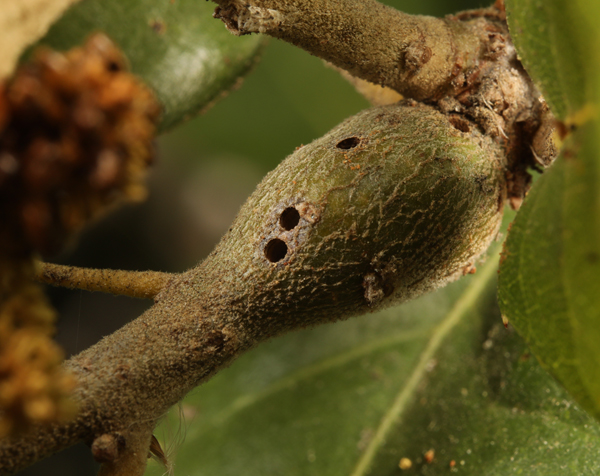
Callirhytis quercussuttoni gall with exit holes where wasps emerged. On Quercus agrifolia (coast live oak).
|
There are museum specimens of Holocynips humicola galls and wasps collected decades ago but as far as I'm
aware nothing recently collected. The specimens I've seen from the California Academy of Sciences
and the Essig Museum are all from Q. wislizeni.
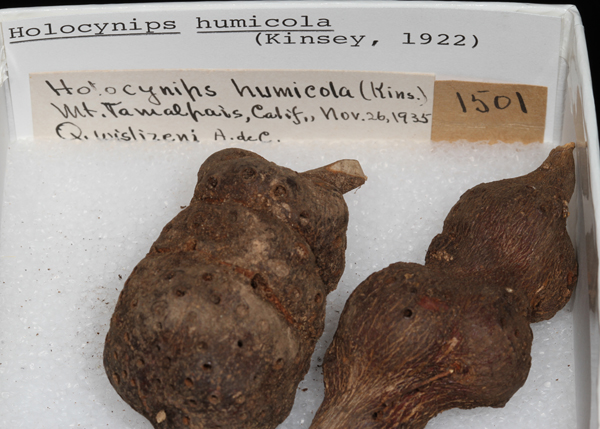
Galls labeled Holocynips humicola from Quercus wislizeni (interior live oak) at the California Academy of Sciences.
|
In November 2021, Diane Erwin and I found what we thought to be H. humicola galls on
roots of a large Q. agrifolia. The galls were between half an inch to 6 inches under the soil. The surface of
the galls was
reddish-brown. The tree also had a lot of integral stem galls above the soil.
We assumed the galls above ground to be the commonly-seen Callirhytis quercussuttoni galls.
The galls above ground were not reddish-brown -- the surface was like that of the branches -- but
otherwise those galls looked similar to the galls on the roots.
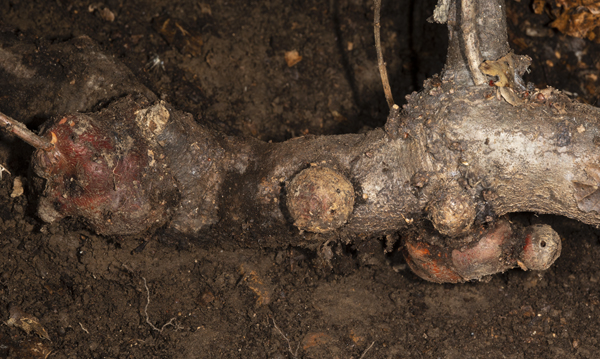
Root galls from Quercus agrifolia (coast live oak), Oakland, CA, November 2021.
|
I collected a gall from a root under the soil. I dissected it on the same day and found fully formed
adult wasps and also some very small larvae. The adults appeared to be the inducers of the galls. Other options
for wasps inside galls are parasitoids or inquilines (= "uninvited guests").
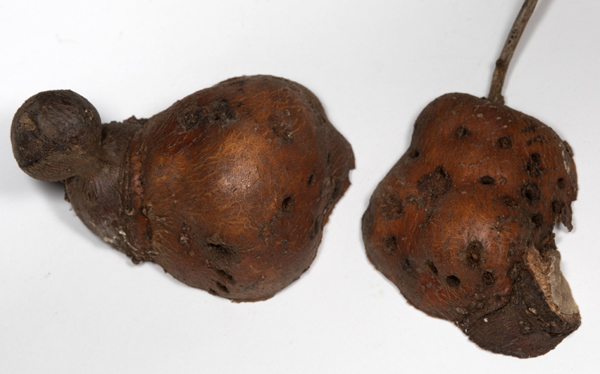
Root gall cut in half, from Quercus agrifolia (coast live oak), Oakland, CA, November 2021.
|
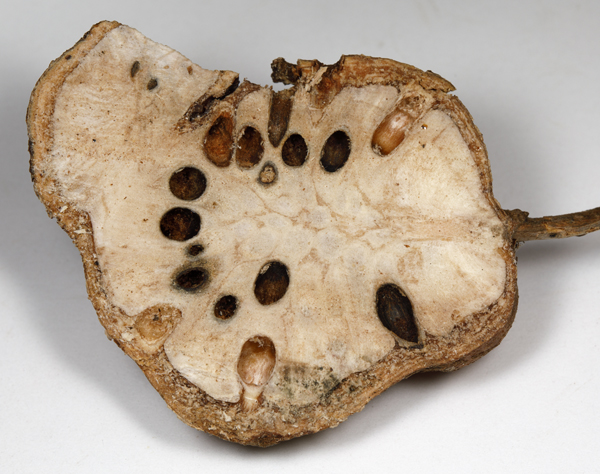
Root gall cut in half, with larval chambers visible. From Quercus agrifolia (coast live oak), Oakland, CA, November 2021.
|
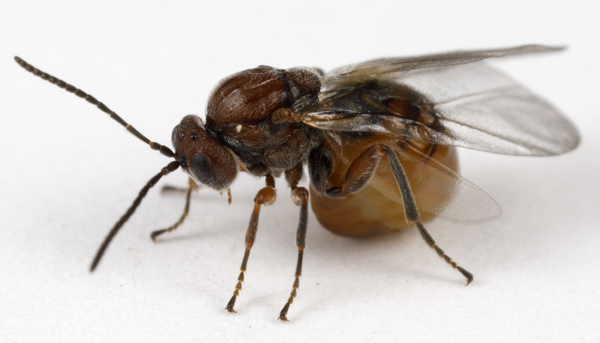
Adult wasp from root gall on Quercus agrifolia (coast live oak), Oakland, CA, November 2021.
|
In January 2022, some wasps emerged on their own from the remainder of the gall that I had not dissected.
The wasps were identical to
those that I dissected out the previous November.
I also collected some Callirhytis quercussuttoni galls in November 2021 and dissected out some adults.
The adults looked quite like those from the Holocynips humicola galls. Of course, adult cynipids
all tend to look similar no matter what the species .... small and brown.
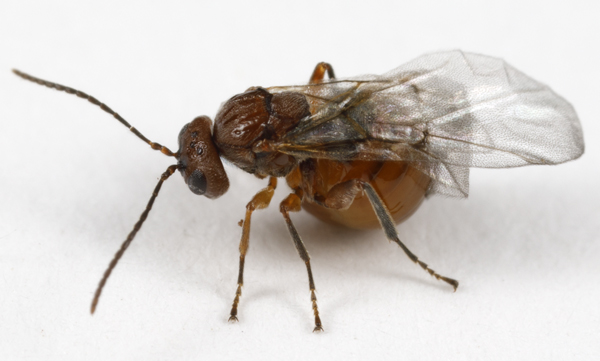
Adult wasp from Callirhytis quercussuttoni stem gall on Quercus agrifolia (coast live oak), Oakland, CA, November 2021.
|
In February I sent some adult wasps from the Holocynips humicola galls to James Nicholls (CSIRO, Australia).
James and his colleagues are working on a phylogeny
of Cynipidae of the world. James sequenced them, and they
came out so close to Callirhytis quercussuttoni that he concluded my Holocynips humicola wasps
were really Callirhytis quercussuttoni wasps. What
were their galls doing below ground?
I then went to the Essig Museum and photographed the four Holocynips humicola specimens that are in the museum. They looked
nearly identical to the wasps from my Q. agrifolia root galls. James and I also looked at photos
his colleague took of another Holocynips humicola specimen. That specimen, too, looks very much like
Callirhytis quercussuttoni. In addition,
images of the Holocynips humicola
holotype (specimen from which the species
was described) at the American Museum of Natural History look similar to Callirhytis quercussuttoni.
Is it possible that Holocynips humicola is really the same species as Callirhytis quercussuttoni?
Since root galls on oaks are hard to find due to their location underground, people have rarely seen
them and there aren't many in museum collections. It would be interesting to see images of root galls
from any fallen red oaks. If there are two species that gall their roots, do the galls look different?
In the few museum specimens I've seen, the galls do not look obviously different to me.
Are there adults in any of these root galls that look different from Callirhytis quercussuttoni adults?
Additional information:
California red oaks also host a gall wasp
Callirhytis apicalis whose
galls grow at the base of trunks,
just above and just below the soil line. This gall is distinctly different from
Holocynips humicola and Callirhytis quercussuttoni galls in that it only contains one larva/wasp
inside a centrally located chamber. The area between the larval chamber and outer edge of the gall is somewhat
spongy and soft, versus very hard and woody in Holocynips humicola and Callirhytis quercussuttoni.
Here is Kinsey's 1922 description of Holocynips humicola galls: "Large, irregular, tuber-like, woody swellings
of the bark and new wood of roots. Agglomerate. The swellings are very irregular, smooth
and rounded when fresh, roughening with age; the fresh bark covering is more reddish brown
than on the normal roots; length up to 10.5 cm., the diameter 7.5 cm. on large galls. Affecting both wood
and bark, including wood below the normal line of the bark; larval cells lying toward the bark, oval
3.5 by 4.5 mm., with a thin, distinctive tissue lining the cells, but not separable from the wood. On the
sides of large roots, well below the surface of the ground, on Quercus kelloggii."
References:
Kinsey, Alfred C. (1922)
New Pacific Coast Cynipidae (Hymenoptera). Bulletin of the AMNH ; v. 46, article 3
Russo, Ronald (2021) Plant Galls of the Western United States
Weld, Lewis H. (1957) Cynipid Galls of the Pacific Slope
Web sites:
Note that the identification of any Holocynips humicola galls on the sites below does not mean they
are really Holocynips humicola. They are just best guesses based on gall location on the host and what
little is known about this species. I thought my Quercus agrifolia root galls were Holocynips humicola,
too, until I found out they weren't.
iNaturalist Callirhytis quercussuttoni images
iNaturalist Holocynips humicola images
Gallformers web site Callirhytis quercussuttoni page
Gallformers web site Holocynips humicola page
My web page with photos of many California oak galls.
|